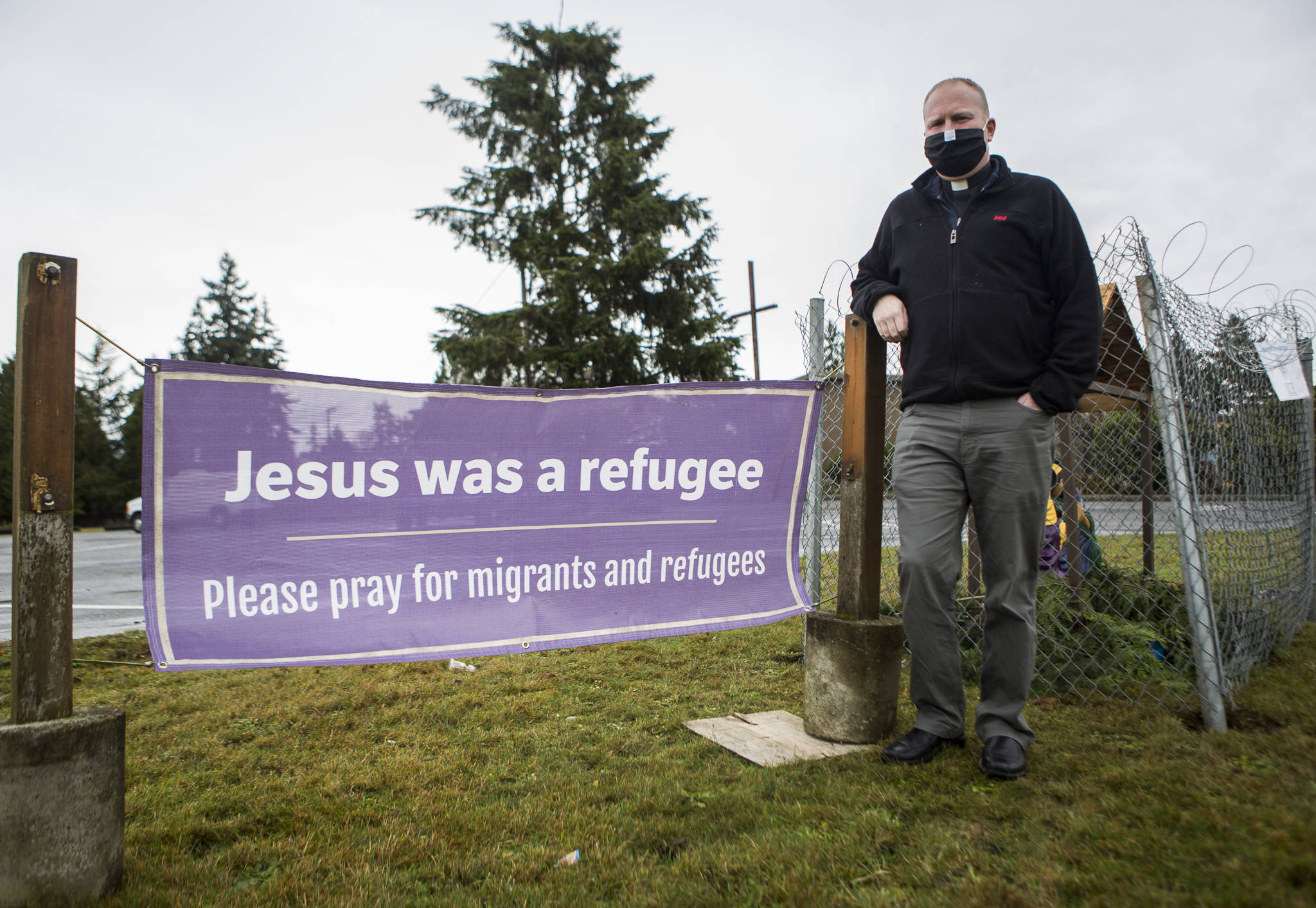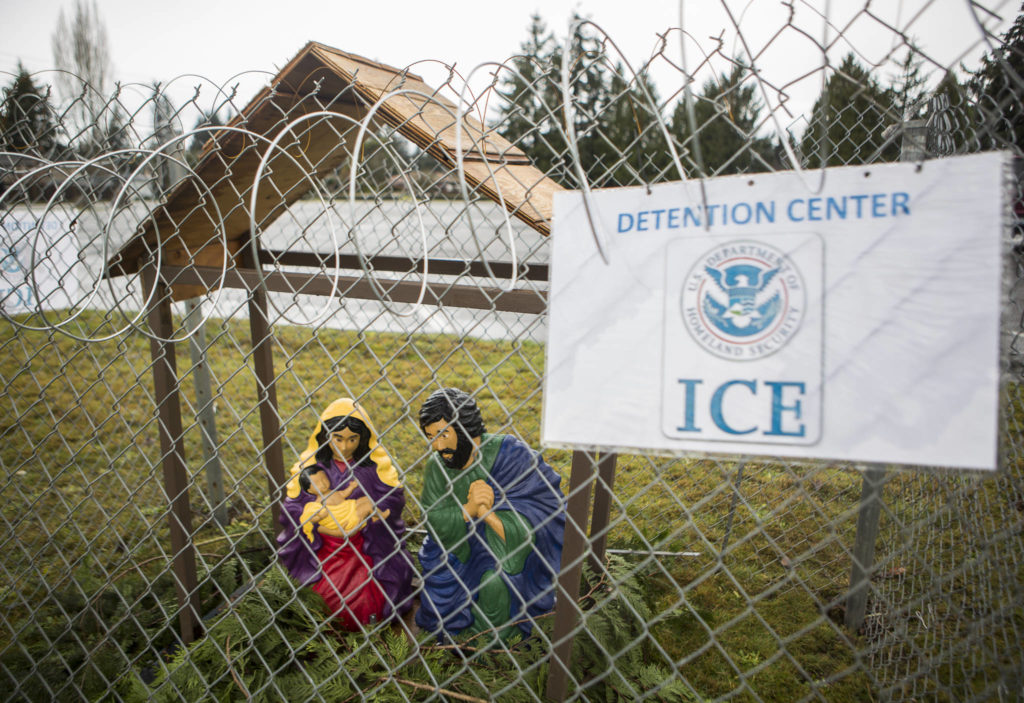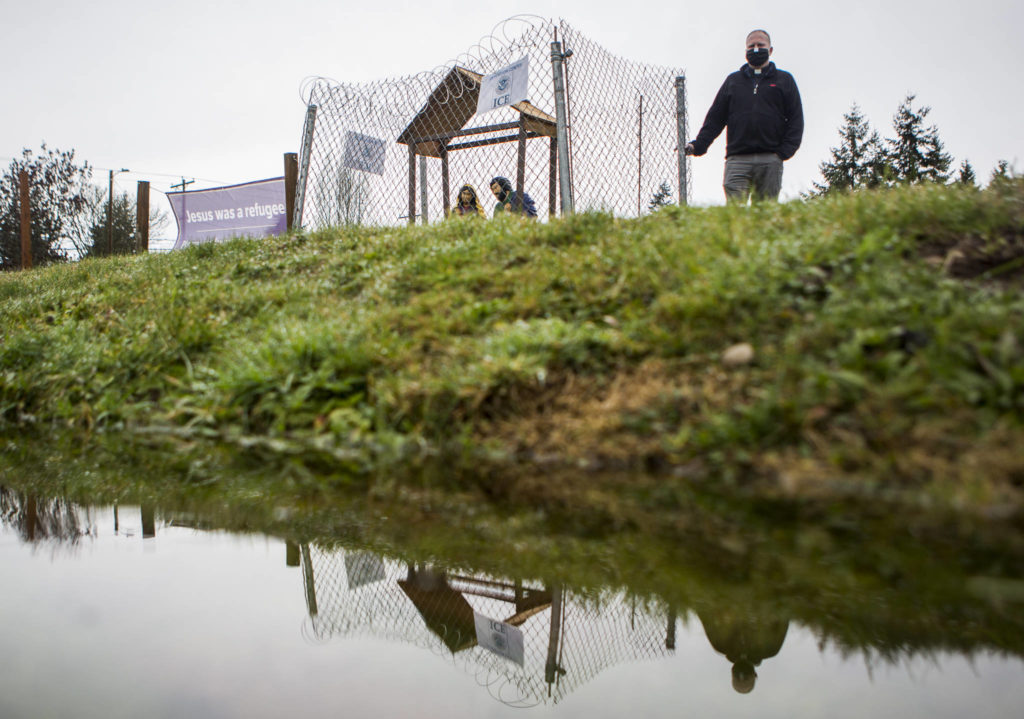At this time of year, faithful Christians center their attention on the birth of Jesus. Pastor Tim Oleson, leader of Edmonds Lutheran Church, believes many don’t think much about what happened next.
What happened, according to the biblical story in the Gospel of Matthew, is abbreviated on a sign near the church’s outdoor Nativity display: “Jesus was a refugee.”
Next to that is a jarring sight. The figures of Mary, Joseph with Jesus are enclosed by chain-link fencing topped with coiled wire. The display includes an ICE (Immigration and Customs Enforcement) Detention Center sign and one that says, “Please pray for migrants and refugees.”
Oleson was part of a church group on a week-long border immersion trip two years ago to El Paso, Texas, and Ciudad Juarez, Mexico.
“The team was really moved by the stories we heard,” said the pastor, who was at the church Sunday leading a service recorded for online streaming.
Those stories included one family’s separation after parents brought their daughter to the United States for treatment of a heart condition, he said. “The mom and daughter were OK, they were documented. The father was detained and deported,” Oleson said.
He sees parallels between those modern struggles and the plight of the Holy Family told in the second chapter of Matthew.
It’s the story of the Flight into Egypt, following the birth of Jesus in Bethlehem in the time of King Herod. After the visit by the Magi, Matthew 2:13-23 tells of an angel appearing to Joseph in a dream. The angel tells Joseph to flee with the child and his mother to Egypt, as Herod is seeking to find and kill Jesus. The account goes on with Herod carrying out the killings of all male children of Bethlehem under age 2.
“It’s an often overlooked part of the Christmas story. They had to flee because of violence — the very definition of a refugee,” Oleson said.
He’s far from the only clergy member to make the comparison.
“A refugee is someone who has been forced to flee his or her country because of persecution, war, or violence,” the Rev. James Martin, a Jesuit priest, author and editor-at-large for the Catholic magazine America, wrote in a 2017 article titled, “Were Jesus, Mary and Joseph refugees? Yes.”
“People are just trying to survive,” said Oleson, whose travel group was hosted by a congregation on the U.S. side of the border. “About 10 of us went to El Paso, teens to an 86-year-old,” he said. “It was a week before Christmas. We helped with food bags for families. It was a powerful trip.”
Social justice is valued at Edmonds Lutheran Church, where a Black Lives Matter flag flies from the rooftop. Its weekly community meal, 5-6:30 p.m. Wednesdays, is now a drive-through serving more than 100 people each time.
Suzy Baroud, communications coordinator for Edmonds Lutheran Church, was part of the travel group. In an email, Baroud wrote of learning from migrant families about living life “in the shadows.”
“Parents were afraid to attend their children’s school activities, parent-teacher conferences, musical performances, sporting events, etc. They often opted out of programs like the free and reduced lunch program,” she wrote.
While shedding light on the human toll of immigration policies, Baroud said the families “showed our group an overwhelming amount of kindness and hospitality” in homes lacking water and electricity.
Oleson has heard from people opposed to the caged manger scene, but also from some who appreciate it. “It’s Christmas. They don’t want to be confronted with more uncomfortable feelings,” he said. “We have gotten people saying thank you.”
In October, the Trump administration capped the number of refugees it will admit into the United States over 12 months at 15,000. That’s the lowest since the 1980 Refugee Act took effect, according to The Washington Post. It’s a drop from the 2020 cap of 18,000, which was a big decline from the 30,000 allowed the previous year, The New York Times reported in September 2019.
Oleson let the church’s council know about the Nativity display but said, “I get the final say. I gave my blessing.” He wanted to create awareness around the issues of migrants, refugees and asylum seekers. “Our tax dollars are going to detain people — people seeking safety. Let’s have a conversation,” he said.
He sees the display’s sign — “Please pray for migrants and refugees” — as a unifying rather than political message. The issue has been long on his mind. “I was aware of this 12 years ago. I visited the Northwest Detention Center,” he said.
“We aren’t calling for flinging wide open the borders. We’re looking for a safety approach, and a compassionate approach,” he said. “We can do better.”
Julie Muhlstein: jmuhlstein@heraldnet.com
Talk to us
> Give us your news tips.
> Send us a letter to the editor.
> More Herald contact information.




























